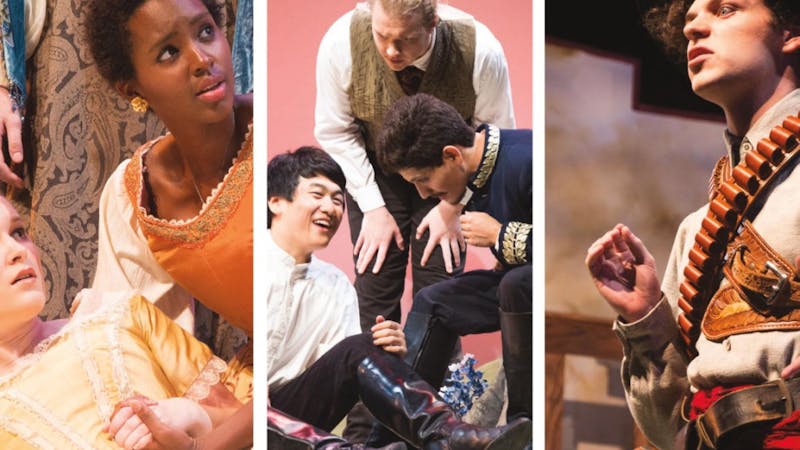NEWS
10/20/15 7:46pm
By Hannah Che
As Real Food Week kicks off, students may find themselves wondering about the food sourcing process behind the food prepared in the serveries. A closer look reveals the steps Housing and Dining is taking toward sustainability, including creating weekly menus based on availability of seasonal ingredients and sourcing regularly from the Farmers Market. Each of the head chefs at the six serveries are responsible for food sourcing, weekly menu determination and independently purchasing food. According to Senior Business Director of H&D David McDonald, menus are often based on a rotational system at other universities, where the food served for each meal is determined months in advance. McDonald said he was critical of a cycled menu, since problems such as a blight in produce or a recall on a certain item could occur.“Just look at the current situation: The market is experiencing a massive shortage of eggs that’s severely affected our egg supply,” McDonald said. “So imagine if you had an egg-heavy menu published three months ago, and you didn’t know this was going to happen — you’d have a serious problem on your hands.”Head chefs research prices, look into reports from seafood and produce companies, talk to local farmers, and based on that information, determine the menus for the next week at their respective serveries. “Because we know exactly what’s available to us, we don’t have to guess — we can plan and cook based on real time information,” Campus Dining Director Chef Johnny Curet said. “The flexibility allows for menu modifications to be made in case of unanticipated food source changes.”Richard Johnson, director of the Rice Administrative Center for Sustainability and Energy Management, said the system minimizes food waste and maximizes cost efficiency. “If you have a better sense, in the moment, of what’s going to be available, and where you can get it and what the prices are going to look like, you’re going to make decisions that will be less wasteful,” Johnson said.The serveries’ primary food supplier is Houston-based Sysco, according to McDonald. Around 20 to 25 percent of ingredients are sourced locally within a 200-250 mile-radius including seafood, poultry and Blue Bell ice cream. Due to the limited range of in-season produce in Texas, however, it is difficult to increase the percentage of locally-sourced foods.“If we were in Salinas, California, I could easily purchase 80 percent of my product from nearby farms,” McDonald explained. “Here in Houston, a 250-mile radius doesn’t leave us with many options, besides lots of okra and oranges.”Another food source is the Farmer’s Market, which currently accounts for less than 10 percent of the food purchased by the serveries. The market is owned and operated by Rice, and the chefs began directly purchasing from the market around two years ago. Hardwick said that H&D has worked hard to streamline the process of ordering and delivery, and these steps have made it easier for chefs to incorporate ingredients from the Farmers Market into their menu.“Each week, they’ll call in and let us know what they need, and we let them know what we have growing right now or ready to harvest in the future,” Gage Lydahl from Atkinson Farms said. “Besides supporting the Farmers Market, Rice University helps us by purchasing around $400 to $500 of produce weekly.”The local vendors are limited in production capability and selection, however. McDonald said with the sheer volume of food that is produced for each meal at the serveries, the largest farm vendor at the market would not even be able to supply Rice for a single lunch. “We try to purchase whatever they have, and as much as they have,” Glenn said. “Some examples of items we’ve purchased include local honey for National Honey Month and free-range bison meat for tacos at Seibel.”Manager of Communications Susann Glenn said that purchasing from the local farmers contributes to the sustainability of the local economy, especially in cases of surpluses, when Rice can purchase the excess and freeze it for later use.“The farmers like that sense of security, knowing that if they have extra product, we’ll take it off their hands — that’s financial stability for them,” Glenn said. “And it means the world to them.” Real Food Revolution is a student organization focused on increasing support for local foods and sustainable farming practices, and they have partnered with H&D on multiple occasions to host events like Farm to Fork dinners. Co-President Belle Douglass said she acknowledged the challenges of purchasing locally, but added that there are ways the university can take even more advantage of what Houston and surrounding farms have to offer. “Our chefs are so talented that the fact that local options change with the seasons shouldn’t be a reason not to buy locally,” Douglass, a Martel College senior, said. “Additionally, buying locally can at times be more expensive than buying in bulk from other sources, so if we want to see an increase in local food then perhaps a change to the way food budgets are structured might help. Setting a required amount to be purchased locally might be an option to explore.”Another food source is found in the on-campus gardens, a club currently run by Rice Community Growers, inspired by Joseph Novak’s Community Garden course (EBIO 204).“Although the gardens last year did not produce enough for regular use by the serveries, we did supply the chefs with some herbs — mostly basil, parsley and cilantro, and sometimes lettuce and arugula,” Lovett College junior Emma Livingston, who had taken Novak’s course, said.H&D is working on further ways to support sustainability in food sourcing, McDonald said. Purchasing imperfect produce for use in the kitchens is one initiative in progress. “Most of these items can’t be sold retail — the quality and taste is just as good, but people won’t buy them in grocery stores because they are oddly shaped, or have blemishes,” McDonald said. “It’s a consumable product that’s not being utilized; if those items don’t get bought from a farm, they will be thrown away.”Douglass said the weekly menu creation permits chefs to take suggestions into consideration when planning the next week’s meals.“Housing and Dining takes suggestions [from the Rice Dining website] seriously and the best way to have a voice in what you’re eating is to engage with the people who are making it,” Douglass said. “If you want to see more local food, tell your chef!”



